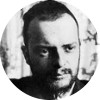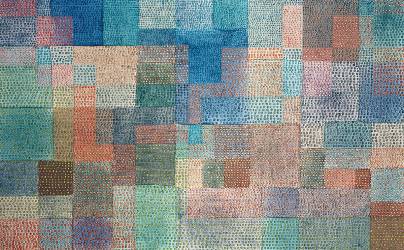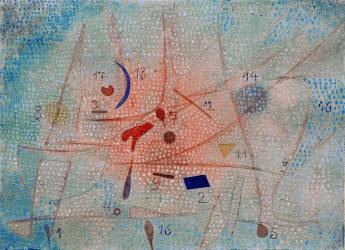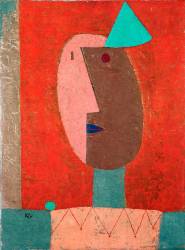Paul Klee canvas prints & artprints
A major figure in German painting and in the history of contemporary art in the first half of the 20th century, Paul Klee brought abstract and figurative expressionism to the fore, with canvases whose brushwork and color composition were a veritable revolution in his day. A great art theorist, Paul Klee drew on different painting styles to create his own unique vision of modern art.
Discover the finest achievements of one of the precursors of modern and contemporary art, with his canvas "Dispute", one of his oil paintings on burlap playing on the tonalities of green and red colors, his abstract painting "Polyphony", an abstract representation of music in a geometric and colorful ballet, or his canvas "Castle and Sun (n°201)", a perfect illustration of Expressionist figurative art, bridging the gap between the figurative and the abstract.
Treat yourself to a reproduction of one of Paul Klee's artworks available in the catalog, and, from the Bauhaus in Weimar to the Paul Klee Foundation in Bern, discover the biography of one of the most influential modern artists of his time.
Biography of Paul Klee
Paul Klee's training: many artistic influences
Paul Klee was born in Bern, Switzerland, in 1879 to a German father and a Swiss mother, and came from a family of artists, especially musicians. Initially trained as a musician, Paul Klee was soon attracted to drawing, and so, after his A-levels in 1898, he attempted to enter the Academy of Fine Arts in Munich, Germany. However, the young German painter in the making was not accepted, and so headed for the studio run by Heinrich Knirr, where he learned figurative art. Heinrich Knirr was one of the great German painters of figurative painting and realism.
Highly gifted, Paul Klee tried his luck again, and was finally accepted at the Munich School of Fine Arts in 1900, where he joined the studio of symbolist painter Franz von Stuck. During these formative years, alongside other illustrious students such as Jean-Edouard Castella, and the future exponent of abstract painting, Vassily Kandinsky, Paul Klee continued to study pictorial figuration, and also became interested in other techniques, notably during his travels to Germany and Italy, where he discovered the works of art of Francisco Goya, William Blake, Michelangelo and the Italian Renaissance. It was also during this period that he learned sculpture and lithography.
On a trip to Paris in 1905, Paul Klee, not yet oriented towards abstraction and geometric forms, discovered the Impressionist art movement. On this occasion, he met Cézanne, Matisse and Derain, and was in awe of the color and light that emerged from the Impressionist artists' paintings. In 1906, he returned to Munich and married Lily Stumpf, with whom he had a son, Félix. In 1907, he began experimenting with caricatures and portraits under glass, a sign of his interest in all styles of painting and art forms.
Paul Klee: a young painter obsessed with color
In 1910, Paul Klee was definitely inspired by the Impressionists and the paintings of Manet, Vincent Van Gogh and Claude Monet. However, he went against his contemporaries and did not adopt this pictorial trend. Unlike the Impressionists, who sought to represent the light of the moment through color, Paul Klee began to search for light by playing on tones rather than hues. It was during this period that he produced a series of colored works in oil on canvas, black watercolors and drawings whose line gradually moved away from academicism, and that he held his first exhibitions, such as at the Museum of Fine Arts in Bern.
He also became close to the German Expressionist painters, with whom he took part in the first exhibition of the Cavalier Bleu (Der Blaue Reiter). After the second Blue Rider exhibition, Paul Klee travels once again to Paris, where he makes contact with Robert Delaunay, a master of color arrangement and pioneer of Orphism, a sub-branch of Cubism. Through his contact with Delaunay, Klee further developed his palette, applying the French artist's precepts to his canvas.
In 1913, Paul Klee became the instigator of the New Munich Secession movement, alongside printmaker Albert Weisgerber, Expressionist painter Gabriele Münter and Vassily Kandinsky. It was also in 1913 that he made a trip to Tunisia, during which the vivid colors of the region led him to the end of his search for color in his work.
World War I and fame for Paul Klee
In 1914, the First World War broke out. Back in Switzerland, Paul Klee was drafted into the military reserves and moved to Gersthofen, where he worked as a secretary at the Air Force Academy. This mission away from the front enabled him to continue painting and exhibiting. During this period, Paul Klee's drawings and compositions became increasingly abstract, but it was with figurative motifs presented at a Berlin exhibition that the artist achieved great success in Germany around 1917.
With German collectors investing in modern art, Paul Klee turned away from abstract paintings for a while, and threw himself fully into Expressionist figurative art. He even tried his hand at experimentation, as with "Jadis surgi du gris de la nuit", a work on hybrid cardboard combining several techniques such as watercolor, pencil on paper and silver paper, or "Mythe des fleurs", a watercolor on a chalk background, using newspaper and silver bronze paper. For Paul Klee, the war was a real period of contradiction. Although he condemned the war and advocated freedom through abstraction, it was also the moment when he achieved the greatest renown in his career, thanks to his figurative works.
Paul Klee, Bauhaus teacher
In 1919, Paul Klee was a well-known painter in Germany. However, this did not prevent the Berlin School of Fine Arts from rejecting his application to become a teacher. In 1920, Paul Klee was called to teach glass painting and weaving at the Bauhaus in Weimar, before obtaining his own studio in 1924, where he lectured, in collaboration with Kandinsky, on an abstract vision of painting and the possibilities it offered within the various artistic movements. A true theorist of modern art, he also lectured at various art academies, published essays such as "The Study of Nature", and continued to produce abstract and expressionist paintings, which he exhibited, notably at Hans Goltz's gallery in Munich.
In 1931, Paul Klee obtained the title of professor at the Düsseldorf Academy of Fine Arts, and music, which had fascinated the artist since childhood, began to be integrated into works featuring a lyrical abstraction that depicts a pictorial rhythm in the colors and geometric shapes used. Always at the forefront of modern painting, Paul Klee's classes are highly appreciated for their modern, contemporary take on art, as well as for their reflection on the abstract dimension of painting.
Paul Klee's last years: exile and illness
Although 10 years earlier, art critics had been raving about Paul Klee's drawings and paintings, with the arrival of National Socialism in Germany, the German artist's art was disavowed, and he was dismissed from the Düsseldorf Academy of Fine Arts in 1932. From 1933 to 1937, his paintings appeared in an exhibition that toured the museums of Germany, showing works that the Nazis called "degenerate art". Paul Klee's paintings, and the modern art movement, were thus subjected to lynching by the German people for the duration of the authoritarian Nazi regime's rise to power.
Unable to work as an artist, Paul Klee fled to his family in Bern, Switzerland, in 1933. In Bern, the German artist continued to paint, but in 1935, a serious skin disease broke out. After a gloomy period, Paul Klee produced numerous canvases with dark themes, the illness having led him to change his state of mind towards the anguish of death. Little accepted in Switzerland, due to the resurgence of former fascist movements in the country, Paul Klee's art never achieved the success it had between 1914 and 1930 in Germany. He was subjected to expert appraisals and interrogations by the Kunstmuseum curator, and was often regarded as a left-wing painter. After leaving Bern for Muralto, Paul Klee died in 1940, due to illness, just before being granted Swiss nationality.
Paul Klee's influence on modern art
Although the exhibition of his works was curtailed at the end of his career, Paul Klee was nonetheless a painter recognized by his peers. As much a specialist in watercolor as in oil painting, with artists such as Kandinsky, who accompanied him throughout his career at the Bauhaus, or Piet Mondrian, the German artist had an artistic influence on all the artistic currents of Expressionism, abstract art and, more generally, modern art, as witnessed by artists such as Joan Miro or Antoni Tàpies, who claimed to be inspired by Paul Klee.
A one-of-a-kind artist, he drew his inspiration from all styles, from classical Italian Renaissance art to modern figurative art, via the Impressionists, to create an inimitable body of work. Today, his paintings can be found in museums all over the world, including the Museum of Modern Art (MoMa) and the Guggenheim Museum in New York, the Centre Georges Pompidou and the Musée National d'Art Moderne in Paris, and the home of his largest collection, the Paul Klee Foundation in Bern.











































